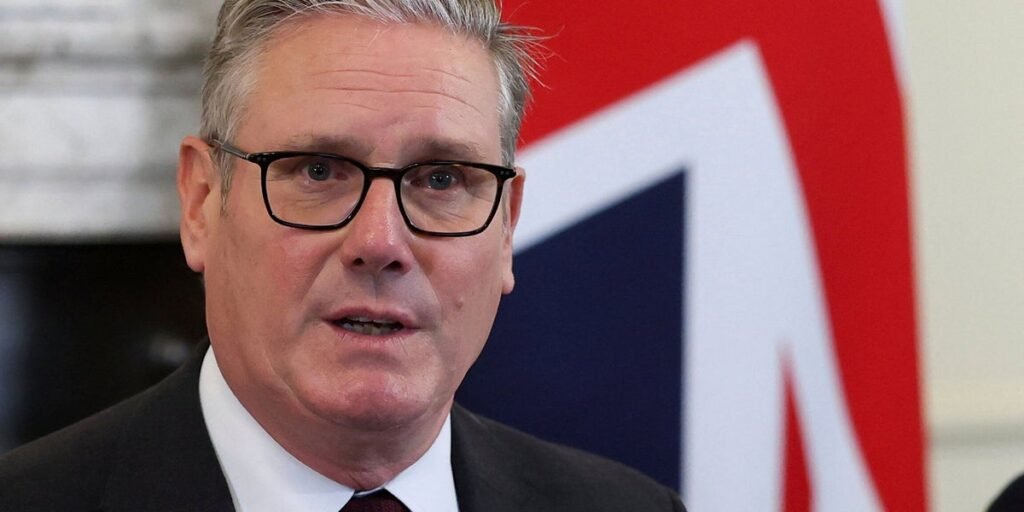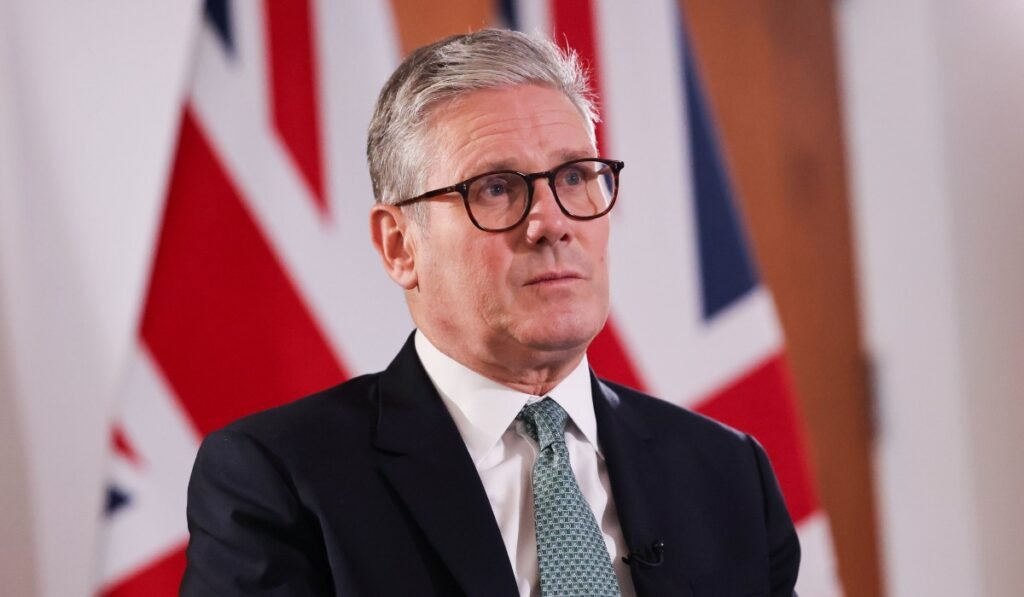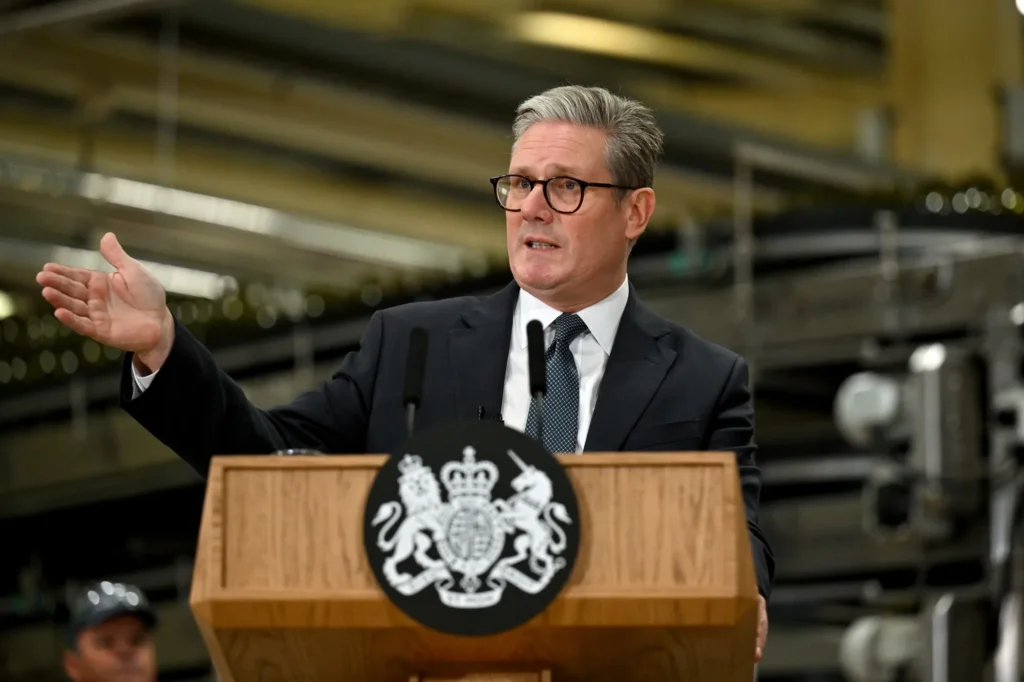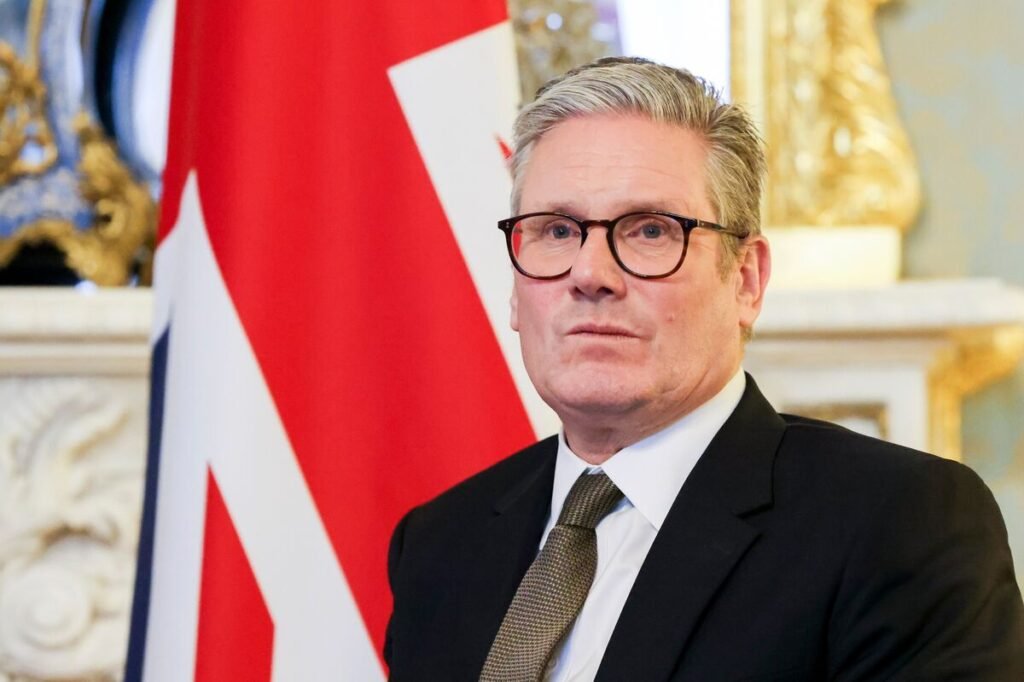The Crowd, The Crisis, and the Collapse of Composure
It started like any other foggy Monday in Westminster—security fences humming, tourists snapping filtered selfies near statues they can’t name, and another carefully curated press release from Number 10 gently massaging reality into a digestible PR sandwich. But today, the mood was different. The pavement outside Downing Street wasn’t just bustling—it was boiling.
Not with tea, not with queue complaints, but with outrage. A river of bodies poured in from Whitehall, Trafalgar Square, and Parliament Street—placards aloft, chants unified, and eyes locked on the black iron gates like hawks circling a lame rabbit. Keir Starmer, nestled inside the polished bubble of bureaucratic insulation, was about to find out what happens when you ignore a nation that’s been simmering for too long.
For weeks, social media had been brewing with fury, outrage, and memes that hit harder than most Prime Minister’s Questions. Starmer’s lukewarm responses to international atrocities, his calculated silence on Gaza, his awkward fence-sitting on war crimes investigations—all of it had built up a pressure cooker atmosphere. When videos surfaced of Labour MPs being silenced in internal meetings, of councillors resigning over moral disgust, and of Starmer giving one more press interview that sounded like it had been drafted by an AI trained exclusively on Blair-era speeches, the dam cracked. But today, it burst.

As thousands chanted outside Downing Street, Starmer was reportedly mid-call with advisors about polling strategy in the Midlands. The irony was painful. Inside, the Labour comms team was debating whether they could squeeze another “We hear your concerns and we stand for unity” tweet without sparking a second protest outside the BBC. But the protest wasn’t just digital now.
It had legs. And signs. And a megaphone that refused to die. The energy outside was electric, and Starmer, insulated by aides and over-filtered information, realized something too late: this wasn’t just a fringe. It wasn’t just the “angry left.” It was Britain. Cross-generational. Multi-faith. Ex-Tories. Ex-Labour loyalists. Students, pensioners, NHS nurses, steelworkers from Sheffield, and disillusioned voters who hadn’t marched for anything since the Iraq War. And now, they were back—with receipts.
The first chants weren’t new—“Keir Starmer, shame on you!” echoed like an old mixtape. But what followed had an edge of finality: “Resign now! Resign now!” It wasn’t just a demand; it was a verdict. Across the street, media vans started rolling in like vultures sensing political blood. Reporters, half-excited and half-confused, scrambled for live shots.
The protest wasn’t just large—it was symbolic. A referendum on Labour’s direction. A public inquisition. And Starmer? He was reportedly “deeply concerned about tone and misinformation.” His team began frantically drafting statements. First draft: “We understand emotions are high.” Second draft: “Now is not the time for division.” Third draft: “The Leader of the Opposition supports peaceful protest and remains committed to listening.” All scrapped. The crowd didn’t want platitudes—they wanted accountability. And it was nowhere to be seen.
Inside the security perimeter, panic had begun to show. Not outwardly, not yet—but in small gestures. Extra guards on standby. Panic whispers among junior staffers. Advisors making sure the blinds were drawn. A source inside the building said Starmer’s expression “shifted from composed to confused to deeply, deeply irritated” as live footage showed the scale of the crowd.
One aide reportedly asked if they could “counter-program” with a visit to a food bank in Sunderland. Another suggested releasing an infographic about public sector pay rises. Both were met with silence. No one wanted another graphics disaster. The last time Labour tried to reframe public outrage with a pastel-coloured bar chart, it trended on Twitter with the hashtag #SpreadsheetShame.
Meanwhile, the crowd outside wasn’t slowing. Makeshift stages formed from milk crates. Speakers took turns denouncing everything from Labour’s foreign policy to its silence on austerity. There were veterans with medals, trade union leaders wielding megaphones like battle standards, students who could recite Starmer’s manifesto promises from 2020 like religious text—and with every speech, the chants grew louder.
“We voted for change, not compliance!” “You’re not Labour, you’re L’Oréal—only here because you’re worth it!” The satirical signs hit hardest. One read: “Even Sunak has a spine—what’s your excuse?” Another: “I left Labour, not because I changed, but because you did.” Starmer’s image, once the beacon of sensible centrism, now plastered on posters as a bootlicker in a Savile Row suit, utterly detached from the crowd that once held him as the next great hope.
Downing Street, usually calm behind its black gates and quiet guard rotations, now stood like a fortress under siege. Not from violence, not from physical threats, but from the one force no politician can endure forever—disillusionment turned vocal. For all his careful branding, his lawyerly precision, his obsession with discipline, Keir Starmer had forgotten the essential truth of democratic leadership: optics matter, but honesty matters more. And when the optics collapse—as they did on this day—what’s left is exposure. Raw. Unfiltered. Unavoidable.

One journalist dared to ask a protester: “What do you think Starmer should do right now?” The response was immediate: “Come outside. No security. Just a mic and his mouth. Let him defend his record to the people who gave him a shot.” But that wasn’t going to happen.
The odds of Starmer stepping outside to face that crowd were lower than the Lib Dems winning Barking. Instead, word spread that he’d been whisked into a secure wing of the building to “monitor the situation.” Translated from political speak: hide, hope the news cycle moves on, and send someone else to the media rounds tomorrow.
The problem? This wasn’t going away. Journalists had footage. Influencers had gone live. The hashtags were multiplying like MPs during a cabinet reshuffle. #StarmerOut, #DowningStreetProtest, #LabourLost, and the truly brutal #RedTories trended within hours. Starmer’s team scrambled to flood the feed with legacy Labour achievements, pictures of him with NHS nurses, awkward shots of him pretending to enjoy Greggs. None of it landed.
One Twitter user replied, “Keir, the last time you cared about working-class people was when you needed their vote. Now it’s just optics and open goals missed.” Another simply posted, “You became the establishment you swore to hold accountable.”
Inside the Labour HQ, damage control meetings bled into each other. MPs were divided. Some publicly supported the right to protest while privately texting colleagues asking if Starmer’s leadership was “sustainable.” Others began whispering about a leadership contest, “not now, but soon.” And one backbencher reportedly said, “We didn’t survive Corbyn just to be buried by this guy.”
The irony wasn’t lost—Starmer had ridden into power on a promise of unity, grown-up politics, and moral clarity. Now he was stuck in a room, blinds drawn, facing chants from thousands demanding his head while his own party plotted behind Zoom calls and burner phones.
Related Post: Watch how Keir Starmer Calls OUT Nigel Farage & Kemi Badenoch in House of Commons LIVE On Air!
And still the crowd grew. Trains delayed, buses rerouted, roads gridlocked—but still they came. From Manchester, Glasgow, Swansea, Belfast. This wasn’t about factionalism anymore. It wasn’t about Momentum vs moderates. It was about the failure of leadership to lead.
One sign summed it up best: “You promised integrity. We got a press secretary.” For a man obsessed with appearing prime ministerial, Starmer had managed to look like the opposite—isolated, unaccountable, and entirely unprepared for a moment that demanded authenticity, not spin.
The final blow of the day didn’t come from a protester or journalist—but from within. A leaked memo surfaced from inside Labour HQ—an internal discussion warning that Starmer’s Gaza stance had “damaged trust irreparably” among key voter groups. The kicker? The memo was dated six weeks ago. The leadership knew. They saw it coming. And they did nothing.
The protest, it turned out, wasn’t just about one issue. It was about being ignored. Again. And in a country still haunted by the ghosts of Blair and Iraq, of broken promises and political gaslighting, it was too much. Starmer didn’t just lose the room. He lost the street. And that, in politics, is how the countdown to resignation begins.
Meltdown in Real Time – When Control Slips, and Cameras Roll
As dusk crept over Whitehall and the orange streetlights flickered on like blinking warnings of an electrical system under strain, the crowds remained—if anything, louder. What began as a march had evolved into a full-blown encampment. Portable speakers blared audio clips of Starmer’s old campaign promises spliced with circus music.
A life-size cardboard cutout of the Labour leader had been fitted with a sign reading “CENTRIST FOR RENT – NO MORALS REQUIRED.” A chant roared through the packed square like a chorus from a rebellion musical: “This is what democracy looks like!” Starmer, somewhere behind the reinforced glass, reportedly muttered, “No, this is what mob politics looks like.” But even his closest aides were starting to question whether it was democracy—or his own detachment—that had led them here.
Inside Number 10’s alternate-reality bubble, things were unraveling at record speed. Crisis meetings were now being held hourly, with no fewer than three PR consultants, two junior press officers, and one visibly sweating MP whispering, “Should we call Wes Streeting?” in the corner. One staffer, visibly exhausted, attempted to calm the room with a PowerPoint slide titled “Strategic Silence: Waiting Out the Anger”, only to be met with the dead-eyed stare of someone who knows full well that silence is now indistinguishable from guilt.

Labour HQ wasn’t faring any better. Calls were coming in from regional party chairs, council leaders, and local MPs all asking the same question: “When is someone going to say something that sounds remotely human?” Starmer’s previous strategy—wait, then release a carefully moderated tweet about unity and the importance of “global conversations”—was no longer enough. Especially not when footage had just gone viral showing him awkwardly avoiding a direct question from a protester at a recent event by pretending to check his watch. The caption read: “Time for what, Keir? Another war crime clarification?” It had over 5 million views within hours.
But the public pressure was only half the crisis. The political class was circling too. Inside Parliament, whisper networks turned into open dissent. An emergency shadow cabinet call, hastily convened and poorly moderated, descended into shouting. An unnamed frontbencher was heard yelling, “We didn’t rebuild the party from Corbyn’s ashes to become the Next Conservative Party! What the hell are we even offering voters now?” The usual suspects—the loyalists, the ultra-pragmatists, the Blair restorationists—had gone quiet. Too quiet. In British politics, that silence means one of two things: either they’re planning a pivot or they’re sharpening knives.
Meanwhile, outside, the protest evolved further. A projector began displaying Starmer’s campaign pledges from 2020 across the front of 10 Downing Street like ghostly reminders. “Support public ownership,” “Promote peace and human rights,” “End outsourcing in the NHS”—each line greeted with boos, jeers, and the kind of public scorn usually reserved for parking wardens on Christmas Eve. For all of Starmer’s careful positioning as a man of principles-within-reason, the crowd saw nothing but betrayal. “You used our hopes like stepping stones,” one speaker roared into a mic. “Now we’re here to rip the ladder down.”
In a last-ditch attempt to calm things, Labour HQ drafted a press statement late that night. It read, in part, “The Leader of the Opposition respects the right to protest and is committed to dialogue with all communities across Britain. He remains steadfast in his commitment to peace and responsible leadership.” It was test-marketed on focus groups before release. One respondent called it “the political equivalent of stale rice.” Another simply wrote: “Who wrote this—ChatGPT?”
Worse, the internal comms leak didn’t stop at one memo. A second document found its way into the hands of the press. This one was brutal. It featured polling data explicitly warning the leadership that “moral ambiguity on international conflicts erodes credibility among young voters and ethnic minorities.” It wasn’t just a warning. It was a forecast. And now that forecast had materialized as thousands outside Downing Street, chanting for a resignation, waving signs that said, “We trusted you. You triangulated us.”
And as if that weren’t enough, a surprise guest entered the scene. Jeremy Corbyn himself appeared briefly at the edge of the protest, greeted like a returning general—part martyr, part messiah. Though he only spoke briefly, the symbolism was deafening. “It’s not about left or right,” he said calmly into the microphone, “it’s about whether leadership listens—or hides.” It was less a jab at Starmer, more a public autopsy. If Keir had once positioned himself as the adult in the room, he now seemed like the only one who hadn’t read the room at all.
Back inside, Starmer’s response was described as “measured but visibly frustrated.” Translation: he was pacing a lot and muttering about headlines. Aides urged him to address the nation—not through press releases or anonymous leaks, but directly. A broadcast. A Q&A. A walkabout. Anything to give the appearance of human contact. But Starmer hesitated. His entire brand was built on avoiding risk, avoiding overpromising, and presenting a curated, professional image. But the crowd didn’t want curated. They wanted contrition.
As midnight approached, the political temperature reached boiling. MPs were openly calling for “reflection,” which in political terms is just short of saying, “Pack your bags.” The next morning’s front pages were unforgiving: “Starmer Besieged by Betrayal,” “Protest Paralyzes Labour’s Future,” and the most vicious of all, from The Daily Mail: “Centrist? More Like Coward.” Even The Guardian, typically sympathetic to Labour under Starmer, ran an editorial asking, “Can Keir Still Lead a Party That Doesn’t Recognize Him Anymore?”
And then it happened. Not a resignation. Not yet. But a crack. A rare, unscripted moment of realness. At 2:14 AM, Starmer appeared on a livestream from inside Downing Street, wearing no tie, eyes red, and voice quieter than usual. He spoke for just under four minutes. “I know many are angry,” he began. “And I know that anger is not just political—it’s personal. It comes from feeling betrayed. I’ve made decisions trying to hold this party together, but I know now that silence can be as loud as action. And maybe, in some ways, I’ve failed to speak clearly enough when it mattered most.”

It wasn’t quite an apology. But it was the closest thing he’d offered since the crisis began. It went viral, of course. Some praised it. Others called it too little, too late. But in the noise of British politics, even a whisper can be seismic when it comes from someone known for scripts. Still, it did little to calm the storm. The protesters stayed. The hashtags trended anew. And the press began openly speculating on leadership challengers. Names swirled—Streeting, Rayner, Nandy, even Burnham hovering in from Manchester like a northern Batman with a regional accent and a Twitter following.
Inside Labour’s higher ranks, calculations began. Could they ride this out? Could Starmer win back the base with a pivot left—or was the damage too deep? Rumours of backbench meetings multiplied. MPs were reportedly told to “clear schedules for emergency strategy sessions.” Meanwhile, Starmer was seen less and less in public. Aides began speaking “on his behalf” more often. And the distance between leader and movement widened like a canyon.
Watch On YouTube
In the end, it wasn’t just about Gaza. Or foreign policy. Or party infighting. It was about a moment—a collision between polished politics and raw public truth. A moment when voters, no longer content to wait for election cycles, took democracy into their own hands. Not through violence. Not through fantasy. But through presence. Through collective voice. Through showing up where power lives and saying: enough.
And for Keir Starmer, the man who promised to rebuild trust, to restore integrity, to be the adult in a broken room—this was the reckoning. Not with opposition parties. Not with the press. But with the very people who once believed he could be different.
They waited outside his window. And they brought the receipts.